Intimate Partner Violence (IPV) in the LGBTQ+ Community
Understanding Intimate Partner Violence in LGBTQ+ Relationships
What is Intimate Partner Violence?
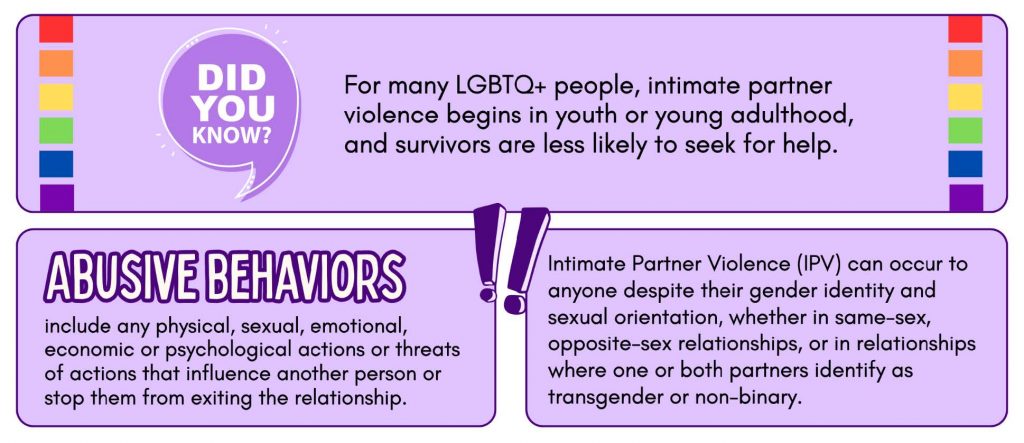
How is the LGBTQ+ community affected?
Because of the complex intersections within LGBTQ+ identities, community members often confront harmful stereotypes and systemic exclusion. The absence of equal rights, support systems, and social advantages compared to their heterosexual counterparts can increase the risk of experiencing intimate partner violence (IPV). These vulnerabilities are sometimes manipulated by abusers, who use prevailing social and economic stigmas as a means of control. Intimate partner violence (IPV) within LGBTQ+ relationships is both underrecognized and underreported, yet it remains profoundly damaging. While the power dynamics may resemble those found in heterosexual relationships, LGBTQ+ partnerships often involve unique forms of abuse shaped by the distinct challenges and vulnerabilities faced by the community. In these relationships, psychological and emotional abuse are more common than physical violence.
What does IPV Look Like in the LGBTQ+ Community?
Developed by Roe and Jagodinsky, the LGBTQ+ Power and Control Wheel is an adaptation of the original Power & Control and Equity Wheels created by the Domestic Abuse Intervention Project. This tool illustrates how abusers may exert control or isolate their partners in LGBTQ+ relationships. By expanding on the classic model used to understand domestic abuse, it incorporates additional tactics that exploit the specific vulnerabilities faced by LGBTQ+ individuals.
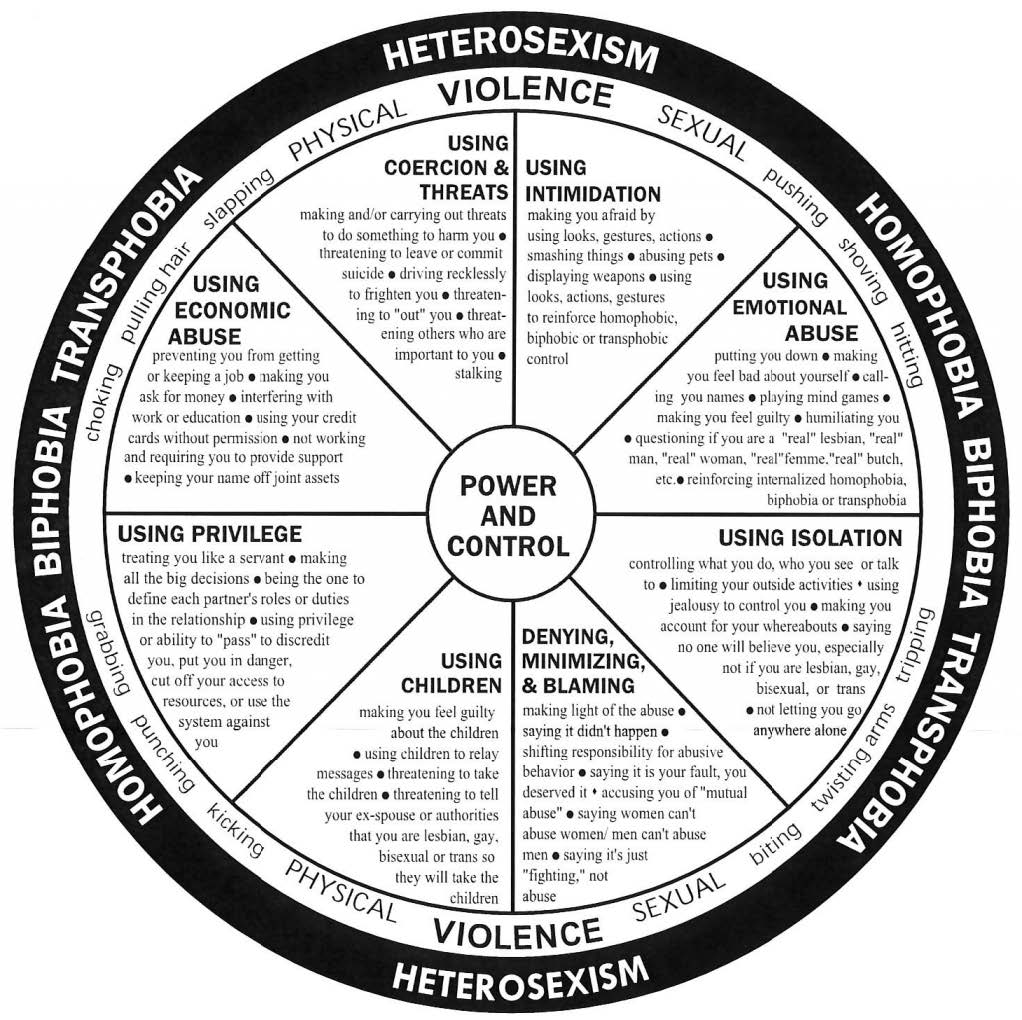
Let’s break down what each component means:
Each element of the wheel is interrelated — abusers often mix these tactics to create an inescapable pattern of control. The LGBTQ+ power and control wheel is a crucial framework for recognizing these behaviors, validating survivors’ experiences, and pointing toward the need for tailored support services that recognize the unique vulnerabilities and strengths within LGBTQ+ communities.
If you or someone you know in the LGBTQ+ community may be experiencing intimate partner violence, you can contact ADV at 201-336-7575 or check out the “Resources” section below to learn more about the resources available.
This graphic portrays key statistics about how intimate partner violence affects different groups within the LGBTQ+ community. It shows that while abuse happens across the board, some groups—like bisexual women and transgender/non-binary individuals—face much higher rates than others. The numbers help highlight where support and intervention are most urgently needed, showing that each segment of the community encounters unique challenges with abuse.
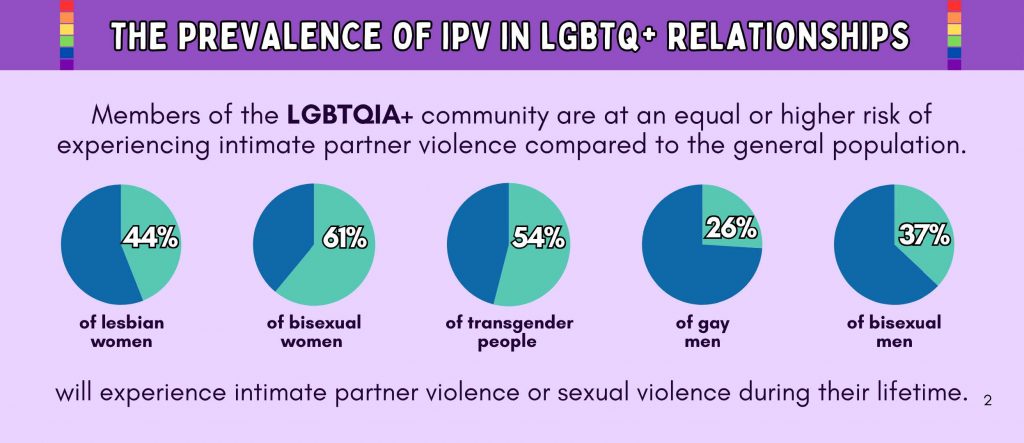
Impacts of IPV on People in the LGBTQ+ Community
LGBTQ+ survivors of intimate partner violence (IPV) face distinct challenges that contribute to increased rates of mental health struggles, substance abuse, and sexual health risks. It is essential to understand the gravity of these impacts in order to create inclusive support systems that address the complex intersections of identity, trauma, and healing.
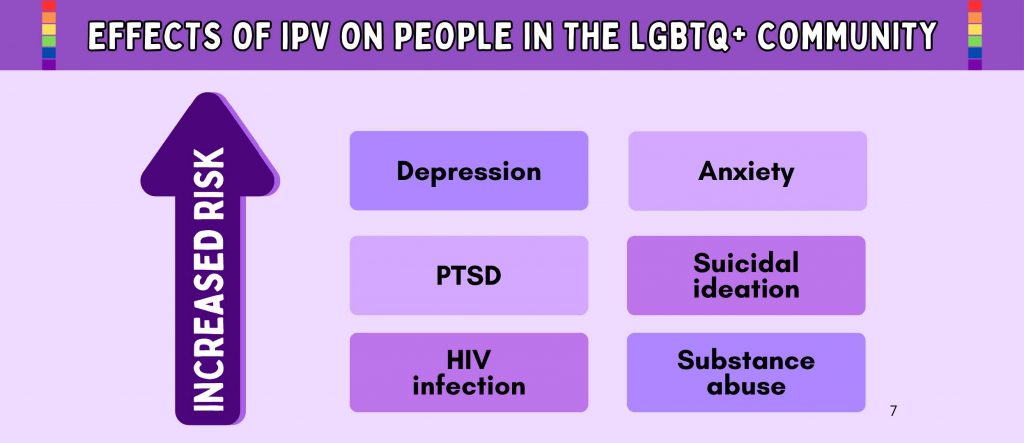
For example, identity abuse occurs when someone’s gender identity or sexual orientation is weaponized, resulting in heightened stress and trauma. This form of psychological manipulation significantly increases the risk of PTSD—especially among transgender and non-binary individuals who frequently encounter additional barriers when seeking support. Moreover, intimate partner violence (IPV) within the LGBTQ+ community is often linked to higher rates of substance abuse and sexual health risks, particularly impacting gay and bisexual men and increasing their vulnerability to HIV infection. Addressing these challenges effectively requires strategies that not only acknowledge these intersecting harms but also work actively to dismantle the systemic barriers that perpetuate them.
What Can You Do to Help?
This graphic can help you understand how to help a loved one in the LGBTQ+ community who may be experiencing domestic violence. Being a supportive ally means maintaining patience and understanding even if your friend isn’t ready to take action immediately. Your role is to empower them with information, ensure they feel safe, and help them explore their options without judgment. Sometimes, educating yourself about the specific challenges LGBTQ+ people face in abusive relationships can also strengthen your ability to help and empathize more effectively.
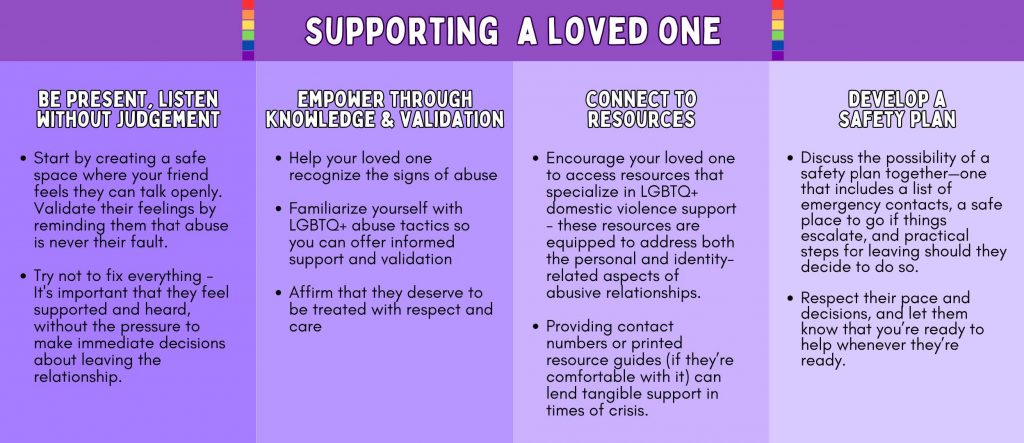
This graphic explains effective ways you can advocate to support LGBTQ+ victims and survivors of intimate partner violence. It outlines key items like increasing accessibility, eliminating stigma, fostering trust, and inclusive research. Being an advocate can help create a safer, more supportive environment.
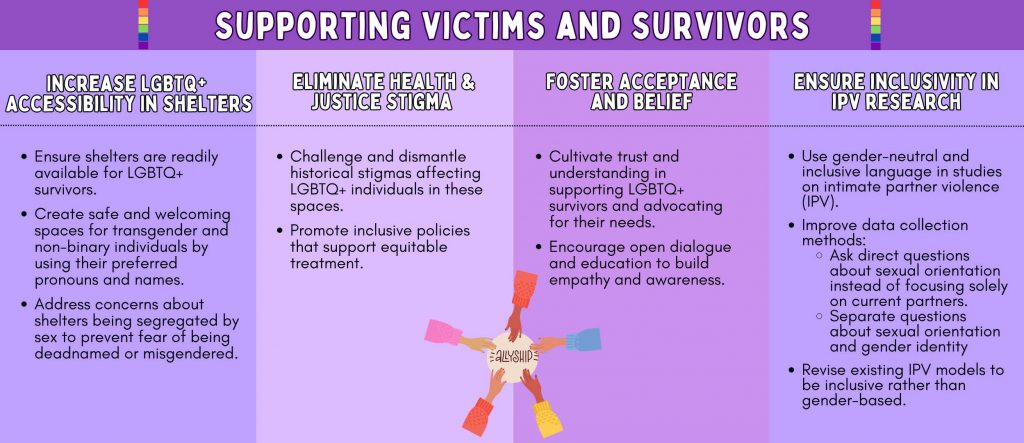
Resources for the LGBTQ+ Community

ADV’s THRIVE Group offers a safe, liberated space for Lesbian, Gay, Bisexual, Transgender, Queer, Intersex, Asexual, and Pansexual (LGBTQIAP+) survivors of intimate partner violence ages 18 and up.
In this group, we cover educational topics that include:
- The dynamics of intimate partner violence.
- Misuse of power in relationships.
- Adaptive safety planning.
- Healthy boundaries.
- Communication skills.
- LGBTQ+ allied community resources.
- Self-care and much more.
All participants will be asked to complete an intake assessment prior to starting group. Please contact the hotline to begin intake: (201) 336-7575.

The Office of LGBTQ+ Services aims to create an inclusive and supportive county where all LGBTQ+ residents thrive with respect and dignity while having access to essential community resources. The Office envisions building strong relationships and partnerships with organizations and allies who advocate for LGBTQ+ rights to end discrimination.
County and Statewide Resources
References:
- Baume, M. (2018, July 18). Intimate partner violence is surprisingly common among gay male couples. Them. https://www.them.us/story/gay-male-intimate-partner-violence-study
- Black, M. C., Basile, K. C., Breiding, M. J., Smith, S. G., Walters, M. L., Merrick, M. T., Chen, J., & Stevens, M. R. (2010). The National Intimate Partner and Sexual Violence Survey (NISVS): 2010 Summary Report. National Center for Injury Prevention and Control, Centers for Disease Control and Prevention.
- Burk, C., & Tucker, K. (2025). Power and Control Wheel for LGBT Relationships | SafeHouse Center – Domestic Violence Services. SafeHouse Center; SafeHouseCenter.org. https://www.safehousecenter.org/power-and-control-in-lgbt-relationships/
- Community Safety Network. (2025). Power and Control Wheel- LGBTQ+. Community Safety Network. https://csnjh.org/en/get-help/what-is-abuse/power-and-control-wheel-lgbtq
- Garthe, R. C., Hidalgo, M. A., Hereth, J., Garofalo, R., Reisner, S. L., Mimiaga, M. J., & Kuhns, L. (2018). Prevalence and Risk Correlates of Intimate Partner Violence Among a Multisite Cohort of Young Transgender Women. LGBT Health, 5(6), 333–340. https://doi.org/10.1089/lgbt.2018.0034
- HRC Foundation. (2022). Understanding Intimate Partner Violence in the LGBTQ+ Community. Human Rights Campaign. https://www.hrc.org/resources/understanding-intimate-partner-violence-in-the-lgbtq-community
- Popowich, D. (n.d.). Intimate Partner Violence in LGBTQ Communities. Rainbow Health Ontario. https://www.rainbowhealthontario.ca/wp-content/uploads/2016/07/RHO_FactSheet_LGBTQIntimatePartnerViolence_E.pdf
- Suarez, N. A., Mimiaga, M. J., Garofalo, R., Brown, E., Bratcher, A. M., Wimbly, T., Hidalgo, M. A., Hoehnle, S., Thai, J., Kahle, E., Sullivan, P. S., & Stephenson, R. (2018). Dyadic Reporting of Intimate Partner Violence Among Male Couples in Three U.S. Cities. American Journal of Men’s Health, 12(4), 1039–1047. https://doi.org/10.1177/1557988318774243
- Swift, J. (2019, November 11). Bisexual women and intimate partner violence. Gender Policy Report. https://genderpolicyreport.umn.edu/bisexual-women-and-intimate-partner-violence/
- Trans PULSE Canada. (2019). Trans women and intimate partner violence fundamentals for service providers. Western University.
Waters, E. (2016). Lesbian, gay, bisexual, transgender, queer, and hiv-affected intimate partner violence in 2015. New York City Anti-Violence Project.
